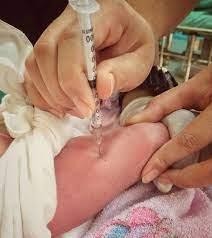A nurse is preparing to administer phytonadione to a newborn. Which of the following actions should the nurse take?
Administer the medication into the deltoid muscle.
Administer the medication 12 hr after birth.
Administer the medication with a 25-gauge needle.
Check the mother's Rh factor prior to administration.
The Correct Answer is C
A) Incorrect- Administering medication into the deltoid muscle is not typically done in newborns. Phytonadione is given intramuscularly, usually in the vastus lateralis muscle, not the deltoid muscle.
B) Incorrect- Phytonadione should be given within 1 hour of birth, not 12 hours after birth. Delaying the administration increases the risk of bleeding complications.
C) Correct- The size of the needle is important for the newborn's comfort, A 25-gauge needle is the appropriate size for administering phytonadione to a newborn. A smaller needle may not deliver the medication adequately, and a larger needle may cause more tissue damage and bleeding.
D) Incorrect- The mother's Rh factor is irrelevant for the administration of phytonadione.
Rh factor affects the risk of hemolytic disease in the newborn, which is a different condition from hemorrhagic disease.

Nursing Test Bank
Naxlex Comprehensive Predictor Exams
Related Questions
Correct Answer is C
Explanation
A) Incorrect- Terbutaline is a tocolytic medication used to relax uterine muscles and inhibit contractions, not to treat an ectopic pregnancy.
B) Incorrect- Magnesium sulfate is used to prevent seizures in clients with preeclampsia, not to treat ectopic pregnancies.
C) Correct - Methotrexate is often used to treat unruptured ectopic pregnancies in the early stages by inhibiting the growth of trophoblastic tissue.
D) Incorrect- Calcium gluconate is used to treat magnesium toxicity and other conditions related to calcium imbalance, not to treat ectopic pregnancies.
Correct Answer is B
Explanation
A) Incorrect- Kegel exercises are helpful for strengthening pelvic floor muscles but may not directly alleviate afterpains.
B) Correct - Afterpains are uterine contractions that occur after childbirth and can be uncomfortable, especially during breastfeeding. Ibuprofen is often used to relieve this discomfort.
C) Incorrect- Applying a cool compress might provide some relief, but pain relief medications like ibuprofen are more effective for afterpains.
D) Incorrect- While a side-lying position can be comfortable for breastfeeding, it may not directly address the afterpains.
Whether you are a student looking to ace your exams or a practicing nurse seeking to enhance your expertise , our nursing education contents will empower you with the confidence and competence to make a difference in the lives of patients and become a respected leader in the healthcare field.
Visit Naxlex, invest in your future and unlock endless possibilities with our unparalleled nursing education contents today
Report Wrong Answer on the Current Question
Do you disagree with the answer? If yes, what is your expected answer? Explain.
Kindly be descriptive with the issue you are facing.
